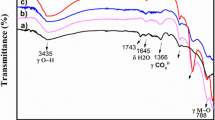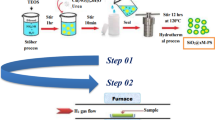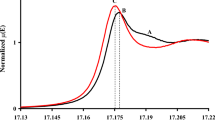Abstract
The influence of factors caused by different experimental conditions on the stoichiometry of thermal decomposition of the complex Ni(NCS)2(β-picoline)4 was studied. By means of TG it was found that the release ofβ-picoline was shown by the derivatograph (air atmosphere, sample of 50–500 mg, rate of temperature increase 1–6°/min, crucible with a hole in the bottom) in three steps (−2, −1, −1), by the micro-balance (sample of 2.59 mg) in two steps (−2, −2), and by the vacuum thermobalance in one step (−4). Under quasi-isothermal and quasi isobaric conditions in a special crucibleβ-picoline was released in three steps (−1, −2, −1). An analogous result was obtained with the derivatograph using a crucible with a lid. The reasons for these differences are discussed.
Résumé
On a étudié l'influence des facteurs en relation avec des conditions d'expérience différentes, sur la stoechiométrie de la décomposition thermique du complexe Ni(SCN)2 (β-picoline)4. On a établi que le dégagement de laβ-picoline s'effectue en trois étapes (−2, −1, −1) si l'expérience TG est réalisée à l'aide d'un Derivatograph (atmosphère d'air, échantillon de 50–500 mg, vitesse d'échauffement 1–6 °C/min, creuset avec fond percé d'un trou), en deux étapes (−2, −2) avec une microbalance (prélèvement de 2.59 mg) et en une étape (−4) si l'expérience TG est réalisée sous vide. En conditions quasi-isothermes et quasi-isobares, dans un creuset de forme spéciale, laβ-picoline se dégage en trois étapes (−1, −2, −1). On parvient à un résultat analogue avec un Derivatograph en utilisant un creuset muni d'un couvercle. On discute les causes de ces différences.
Zusammenfassung
Der Einfluß verschiedener Versuchsbedingungen auf die Stöchiometrie der thermischen Zersetzung des Komplexes Ni(NCS)2(β-Pikolin)4 wurde untersucht. Mittels TG wurde festgestellt, daß der Derivatograph (Luft-Atmosphäre, 50–500 mg Probe, Geschwindigkeit des Temperaturanstiegs 1 bis 6 °C/min., Tiegel mit Loch im Boden) die Freisetzung desβ-Pikolins in drei Stufen (−2, −1, −1), die Mikrowaage (Probe von 2.59 mg) in zwei Stufen (−2, −2) und die Vakuumthermowaage in einer Stufe (−4) angibt. Bei quasi-isothermen und quasi-isobaren Bedingungen in einem besonderen Tiegel wurdeß-Pikolin in drei Stufen (−1, −2, − 1) freigesetzt. Ein ähnliches Ergebnis wurde mit dem Derivatograph en bei Verwendung eines Tiegels mit Deckel erhalten. Die Ursachen dieser Unterschiede werden erörtert.
Резюме
Было изучено влияние факторов, обусловлен ных различными эксперим ентальными условиями, на стехиом етрию термического р азложения комплекса Ni(NCS)2 (βпиколи н)4. С помощью ТГ было найд ено, что дериватограф (воздушная атмосфера, вес образца 50–500 мг, скорост ь повышения температ уры 1–6 °С/мин, тигель с углубл енным дном) показал выделен ие пиколина в три стад ии (−2, −1, −1), микровесовой (вес обр азца 2.59 мг) — в две стадии (−2, −2) и вакуумно-термовесов ой — в одну стадию (−4). При квази-изобарных усло виях в специальном ти гле выделениеβ-пиколина происходило в три стадии (−1, −2, −1). Аналогич ный результат был пол учен на дериватографе, испол ьзуя тигель с крышкой. Обсу ждены причины этих ра зличий.
Similar content being viewed by others
References
W. W. Wendlandt, Thermal Methods of Analysis, Interscience Publishers, New York, 1964.
A. Blažek, Thermal Analysis, Van Nostrand Reinhold Co., London, 1973.
T. Šramko andE. Jóna, Collection Czech. Chem. Commun., 37 (1972) 1645.
E. Jóna, T. Šramko andJ. Gažo, J. Thermal Anal., 7 (1975) 551.
A. K. Majumdar, A. K. Mukherjee andArem K. Mukherjee, J. Inorg. Nucl. Chem., 26 (1964) 2177.
W. Kemula andJ. Czarnecki, Roczniki Chem., 41 (1967) 1463.
M. Menyhárt, G. Liptay andK. Domsa, Magy. Kém. Lapja, 26 (1971) 523.
T.Šramko, E.Jóna and G.Liptay, Proceedings of the 5th Conference on Coordination Chemistry, Smolenice-Bratislava 1974, p. 251.
E. Jóna, T. Šramko, J. Kohout, A. Sirota andJ. Gažo, Chem. Zvesti, 25 (1971) 241.
F. Paulik, J. Paulik andL. Erdey, Z. Anal. Chem., 160 (1958) 241.
W. W. Wendlandt andP. J. Smith, The Thermal Properties of Transition Metal Amine Complexes, Elsevier, Amsterdam, 1967.
I. G. Murgulescu, D. Fătu andE. Segal, J. Thermal Anal., 1 (1969) 97.
F. Paulik andJ. Paulik, J. Thermal Anal., 5 (1973) 253.
E. Jóna, B. Vojtas andT. Šramko, Chem. Zvesti, 30 (1976) 107.
T. Flóra, Acta Chim. Acad. Sci. Hung., 37 (1963) 359.
T. Nobuyuki, K. Masahiro andK. Minoru, Bull. Chem. Soc. Japan, 41 (1968) 2908.
S. M. Nelson andT. M. Shepherd, J. Chem. Soc., (A) 1965, 3276.
Author information
Authors and Affiliations
Rights and permissions
About this article
Cite this article
Šramko, T., Liptay, G. & Jóna, E. Heterogeneous reactions of solid nickel(II) complexes, XI. Journal of Thermal Analysis 12, 217–222 (1977). https://doi.org/10.1007/BF01909478
Received:
Issue Date:
DOI: https://doi.org/10.1007/BF01909478




